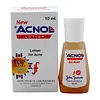Acnol Lotion For Acne Versus Larissa Acne Lotion
What's inside
What's inside
 Key Ingredients
Key Ingredients

 Benefits
Benefits

 Concerns
Concerns

 Ingredients Side-by-side
Ingredients Side-by-side

Alcohol
AntimicrobialWater
Skin ConditioningSulfur
AntiseborrhoeicTalc
AbrasiveZinc Oxide
Cosmetic ColorantSilica
AbrasiveSalicylic Acid
MaskingNiacinamide
SmoothingParfum
MaskingCamphor
MaskingPanthenol
Skin ConditioningAllantoin
Skin ConditioningMenthol
MaskingHexamidine Diisethionate
EmollientSophora Angustifolia Root Extract
Skin ConditioningIsopropyl Cresols
PreservativeCI 77491
Cosmetic ColorantAlcohol
AntimicrobialWater
Skin ConditioningPPG-20 Methyl Glucose Ether
Skin ConditioningSilica
AbrasiveGlycerin
HumectantButylene Glycol
HumectantCentella Asiatica Leaf Extract
Skin ConditioningSulfur
AntiseborrhoeicTalc
AbrasiveSodium Pg-Sulfonate
HumectantSalicylic Acid
MaskingBentonite
AbsorbentPhenoxyethanol
PreservativeEthylhexylglycerin
Skin ConditioningDMDM Hydantoin
PreservativePiroctone Olamine
PreservativeChlorphenesin
AntimicrobialClimbazole
AntimicrobialDipotassium Glycyrrhizate
HumectantSodium Metabisulfite
AntioxidantAlcohol, Water, PPG-20 Methyl Glucose Ether, Silica, Glycerin, Butylene Glycol, Centella Asiatica Leaf Extract, Sulfur, Talc, Sodium Pg-Sulfonate, Salicylic Acid, Bentonite, Phenoxyethanol, Ethylhexylglycerin, DMDM Hydantoin, Piroctone Olamine, Chlorphenesin, Climbazole, Dipotassium Glycyrrhizate, Sodium Metabisulfite
Ingredients Explained
These ingredients are found in both products.
Ingredients higher up in an ingredient list are typically present in a larger amount.
Alcohol comes in many different forms. Different types of alcohol will have different effects on skin. This ingredient is usually an astringent alcohol.
These alcohols are drying on the skin. They may strip away your skin's natural oils and even damage your skin barrier. Astringent alcohols may also irritate skin.
Other types of astringent alcohols include:
According to the National Rosacea Society based in the US, you should be mindful of products with these alcohols in the top half of ingredients.
Any type of sanitizing product will have high amounts of alcohol to help kill bacteria and viruses.
Fatty alcohols come from plant oils such as coconut oil. These can help hydrate the skin and are non-irritating. Some fatty alcohols include cetyl and stearyl alcohol.
Learn more about AlcoholSalicylic Acid (also known as beta hydroxy acid or BHA) is a well-known ingredient for treating skin that struggles with acne and clogged pores. It exfoliates both the skin's surface and deep within the pores to help clear out buildup, control oil, and reduce inflammation.
Unlike AHAs (alpha hydroxy acids), salicylic acid is oil-soluble. This allows it to penetrate into pores which makes it especially effective for treating blackheads and preventing future breakouts.
Salicylic acid is also known for its soothing properties. It has a similar structure to aspirin and can calm inflamed or irritated skin, making it a good option for acne-prone skin that is also sensitive.
Concentrations of 0.5-2% are recognized by the U.S. FDA as an over-the-counter topical acne product.
It can cause irritation and/or dryness if one's skin already has a compromised moisture barrier, so it's best to focus on repairing that before introducing this ingredient into your routine.
While salicylic acid does not increase sun sensitivity, it’s still important to wear sunscreen daily to protect your skin.
If you are looking for the ingredient called BHA or Butylated Hydroxyanisole, click here.
Learn more about Salicylic AcidSilica, also known as silicon dioxide, is a naturally occurring mineral. It is used as a fine, spherical, and porous powder in cosmetics.
Though it has exfoliant properties, the function of silica varies depending on the product.
The unique structure of silica enhances the spreadability and adds smoothness, making it a great texture enhancer.
It is also used as an active carrier, emulsifier, and mattifier due to its ability to absorb excess oil.
In some products, tiny microneedles called spicules are made from silica or hydrolyzed sponge. When you rub them in, they lightly polish away dead skin layers and enhance the penetration of active ingredients.
Learn more about SilicaSulfur is a commonly occurring element on Earth (and our universe!). In cosmetics, it helps kill bacteria, reduces sebum, and provides exfoliation. This makes it an effective ingredient to reduce breakouts and fight acne.
As a ketayolytic agent, it breaks down the top layer of skin. This is a form of exfoliation and may help decrease acne and hyperpigmentation.
Studies show sulfur has antibacterial and antifungal properties. Sulfur can be drying if used excessively or at higher concentrations. We recommend speaking with a medical professional if you have any concerns.
Ancient Greece, India, China, and Egypt have used sulfur in both traditional medicines and for household use.
Learn more about SulfurTalc is a clay mineral. It helps absorb moisture and improve the texture of products. Like other types of clay, Talc can have a slight exfoliating effect on skin. Talc can be added to increase the volume of products.
Some Baby powders are made by combining talc with corn starch. The word "talc" comes from Latin and originates from Arabic. Talc is a mineral commonly found throughout the world.
If you have any concerns about using talc, we recommend checking out the FDA's official page.
Learn more about TalcWater. It's the most common cosmetic ingredient of all. You'll usually see it at the top of ingredient lists, meaning that it makes up the largest part of the product.
So why is it so popular? Water most often acts as a solvent - this means that it helps dissolve other ingredients into the formulation.
You'll also recognize water as that liquid we all need to stay alive. If you see this, drink a glass of water. Stay hydrated!
Learn more about Water